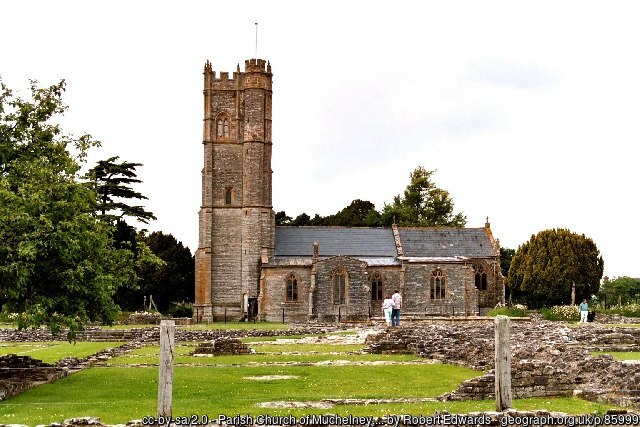You really must visit Muchelney Abbey. If you’re a regular reader of these columns you’ll already be familiar with the name of this Somerset Benedictine monastery. I’ve spent a good (in every sense) part of the past few years researching its fascinating history, a history that encompasses Anglo-Saxon kings, Viking raiders, pious prelates, Oxford scholars, constipated abbots, even German PoWs. Muchelney can also boast some remarkably intact medieval buildings. In these and the adjoining ruins you can read how life at the abbey evolved between the late seventh century and Henry VIII’s Dissolution of the Monasteries over 800 years later.
Sequestered deep in the Somerset Levels, Muchelney was first settled by monks in around 700. Standing on high ground in an area prone to flooding (Muchelney means “great island”), the monastery’s inaccessibility would’ve provided these ascetic Anglo-Saxon monks with the solitude essential for their lives of prayerful contemplation.
The earliest evidence for the abbey’s existence is a charter dating to 693 issued by the pious King Ine of Wessex. It survives only in a 14th-century copy, long dismissed as a late medieval monkish forgery. However, close analysis of the text has redeemed the reputation of the anonymous 14th-century scribe, showing that he was indeed transcribing a genuine Anglo-Saxon document. Ine’s gifts, and those of subsequent Wessex kings, provided the abbey – or minster – with extensive estates in its vicinity. These lands, fisheries and woods provided the basis for the monastery’s wealth for the rest of the Middle Ages.
Despite this royal patronage, the minster was unable to survive the ninth-century Viking raids that devastated monasteries across England. In 939, however, King Athelstan revived monastic life at Muchelney. It was probably around this time that the monks adopted the Rule of St Benedict, its observance at the abbey praised in a contemporary document.
The footprint of the monastery’s diminutive Anglo-Saxon church makes it easy to understand why, in 995, Muchelney was described as a “small monastery”.
Grander days were just around the corner. Muchelney was among the the monasteries and cathedrals given a major makeover in the aftermath of the Norman Conquest. Local elites entrusted the monks with their spiritual salvation, enriching the abbey’s estates and paying for candles to burn before altars during the celebration of Mass. The mid-thirteenth century witnessed further building works, including the renovation of the chapter house, the monks’ dormitory and the adjoining latrine block or “reredorter”. A large portion of this still stands to its full height and the fittings for the bench where the community sat while attending to the “necessities of nature” are clearly visible.
In 1335, the abbey was subjected to a formal “visitation” by the local prelate, Bishop Ralph Shrewsbury of Bath and Wells. No fault was too small to escape censure during this medieval equivalent of an Ofsted inspection from hell. The monks were admonished for leaving the cloister without permission and for erecting “frivolous” canopies above their beds in the communal dormitory.
The records of similar, equally critical visitations survive from the fifteenth century (see my earlier column on monks and alcohol here). When looked at in isolation, they seemingly present a very bleak picture of monastic observance at Muchelney. But they’re just part of the story. Bishop Shrewsbury clearly thought well enough of Abbot John Somerton to endow a chantry for the everlasting salvation of his soul. A century later, Muchelney’s abbot and prior were entrusted “on account of their great learning” with the custody of a heretical Bristol priest.
Further evidence of the erudition of Muchelney’s monks is provided by manuscripts containing astronomical tables and cutting-edge works of theology and popular piety. It’s therefore no surprise that several members of the Muchelney community are known to have been graduates of Oxford University.
But not all manuscript material from the monastery is so high-minded. Successive abbots annotated the flyleaves of the abbey’s breviary with recipes for laxatives and an enema, the ingredients including marsh mellow, soap and mercury.
Hints as to why these were needed are provided by the abbey’s surviving roofed structures. These include the early fourteenth-century kitchen block. Originally a single large space with a central, open fire it was later divided into two by the insertion of a massive wall with back to back fireplaces either side. One kitchen was used to prepare the largely vegetarian fare consumed by the monks in their communal refectory (now ruinous), the other for cooking meaty victuals for the abbot’s table and a special dining room called the “misericord” where the monks were allowed to consume meat. This has recently been identified as the intact late fifteenth-century room adjoining the refectory. Roofed with a magnificent late medieval timber ceiling, there are fragments of fifteenth- and early sixteenth-century painted glass in its windows.
Above this splendid room is the abbot’s chamber, one of the finest monastic domestic interiors anywhere in England. Complete with a sculpted stone fireplace, oak settle and elaborate window tracery containing original glass, its grand scale is a reflection of the exalted ecclesiastical and secular status of the abbots of Muchelney. Even after the passage of half a millennium, the chamber retains the power to impress and intimidate.
Adjoining this are rooms with well-preserved fragments of medieval wall-paintings. Their design replicates costly textile hangings, some showing the influence of the Italian Renaissance. Indeed, the lodging of the abbot of Muchelney was such a des res that it was spared the destruction visited on the church and adjoining claustral buildings when the abbey was dissolved on Henry VIII’s orders in 1538.
Although initially converted into a mansion fit for Tudor gentry, it quickly fell in status, ultimately becoming little more than a farm house. The decaying portion of the fan-vaulted fifteenth-century cloister on the ground floor was used for the storage of cider barrels.
Archaeological investigation of the abbey started in the 1870s. Finds included fragments of the sculpted stonework that ornamented the monastery through its various stages of construction, from Anglo-Saxon to late Gothic. These are now handsomely displayed and explained. Exploration of the site continued after World War Two when an application was made by the Ministry of Works (a forerunner of English Heritage) to employ German prisoners of war. The unearthing of the remains of church of the Anglo-Saxon minster was reported with great excitement in the national press. Today, it’s the monks’ sanitary arrangements and digestive distress that grabs the media's attention. Whatever tempts you to visit Muchelney – and I hope you will – I’m confident you’ll leave with your mind enriched and your spirit refreshed.



 Loading ...
Loading ...
What do you think?
You can post as a subscriber user ...
User comments (0)